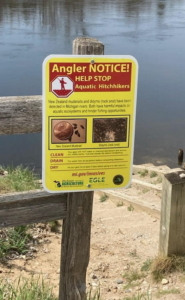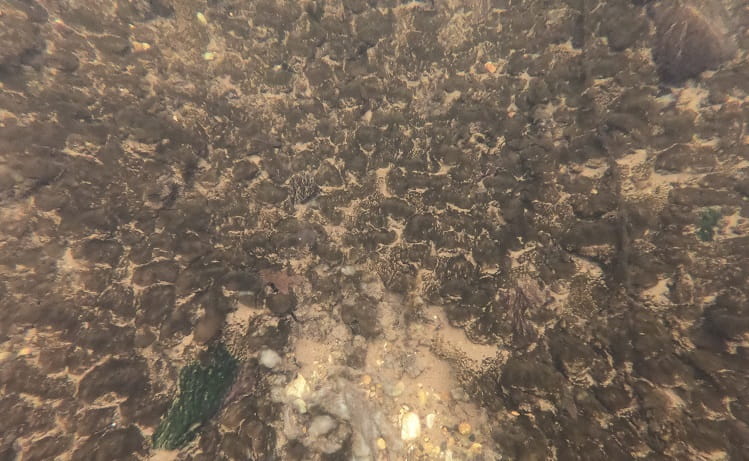Objective: Protect Michigan waters from the harmful effects of Didymo mats
Collect a stream algae sample to help monitor for Didymosphenia germinata (aka Didymo, rock snot) in Michigan waters. Didymo is an aquatic invasive species that forms dense mats in coldwater streams, similar to where trout prefer to live. Anglers can spread Didymo from one stream to another, introducing it to susceptible ecosystems and potentially harming trout populations. Michigan Trout Unlimited’s goal, with the help of TU members, is to monitor Michigan waters for Didymo. Together, we will aid in reducing the spread of Didymo and other invasive species and inform AIS management. Below outlines the process of collecting an algae sample, shipping your algae to Michigan TU, and submitting the necessary sample information needed.

Step 1: What’s in your kit?
- Sample vessel. These are small vials that your samples will be shipped in. They contain preservative (Lugol’s Iodine) that will stain your hands and clothes, avoid contact with it.
- Scrubbing device. Use each toothbrush separately for each sample.
- Weight Boats. These are used to rinse your scrubbing device in after scrubbing rocks or other substrate, you’ll then pour a small volume into your sample vessel.
- Mailer Envelope. Pre-paid label, just drop the package off at a FedEx location or request a pickup here.
Step 2: Choose a sampling location
When out fishing or recreating, consider collecting an algae sample, even if Didymo doesn’t appear to be present. Our goal is to monitor for Didymo, so sampling multiple rocks/substrates in a stretch of stream is ideal. Anywhere that you see ‘streamers’ of filamentous algae or ‘mats’ of algae are extra important to sample, as Didymo often grows in colonial forms. As of November 2024, Didymo has been recorded in the Manistee, Boardman, Au Sable, and St. Mary’s Rivers, but monitoring efforts across MI have been limited; Didymo may be in more locations than what is known.
Step 3: Using Survey123 to submit sample information
 Before you collect a sample, be sure to load the sample information survey. The survey can be completed in the Survey123 app (best if you anticipate having limited cell service, but needs refreshed occasionally), or via your phone’s browser (e.g. Google Chrome, Safari). Ignore the ‘Sign into ArcGIS online’ message if it appears. Please allow Survey123 to access your location and camera, as the survey requests pictures the stream reach and sample location. The TU RIVERS program also uses Survey123 and here is that program’s webpage with more Survey123 info.
Before you collect a sample, be sure to load the sample information survey. The survey can be completed in the Survey123 app (best if you anticipate having limited cell service, but needs refreshed occasionally), or via your phone’s browser (e.g. Google Chrome, Safari). Ignore the ‘Sign into ArcGIS online’ message if it appears. Please allow Survey123 to access your location and camera, as the survey requests pictures the stream reach and sample location. The TU RIVERS program also uses Survey123 and here is that program’s webpage with more Survey123 info.
Step 4: Sample survey, collection, preservation, and shipping guidelines
- Assess the stream where you collected your sample and complete the required survey. You’ll be asked to describe the stream, provide a GPS location (simply by turning on your phone’s location data briefly), and provide your name and contact info. The more information we can collect about where Didymo is found, or not found, the better. This information will contribute to our understanding of Didymo’s preferred habitat and where prevention efforts should focus.
- Collect your sample. Your kit has supplies for one sample. If ‘streamers’ or ‘mats’ are present, collect a very small piece and place it into your weigh boat.
- Collect rocks, wood, or aquatic plants (if present) and scrub the side that was facing the sun with the toothbrush from your kit. Put a small amount of stream water in the weigh boat, just barely enough to cover the bottom. Rinse the algae on your scrubber in the weigh boat, concentrating as much scrubbed off ‘biofilm’ in the weigh boat as you can. Remember that the cells we are looking for are microscopic, so we only need a very small sample. Pour your sample from the weigh boat into the vial by bending the weigh boat and pouring. Note that vials contain a small amount of Lugol’s Iodine as preservative, which may stain your hands or clothes. Repeat this process using a separate kit if sampling further than 100 meters away from your initial sample location. If you sample in more than one place, label your vial with a permanent marker to distinguish it from other samples. Include your vial label in your Survey123 form, and complete one survey for each sample collected. The survey is how we know where you sampled and what the conditions in the stream were like, so its critical that you complete the survey for each sample.
- Ship your sample. Your kit has a pre-paid shipping label that will deliver you kit to Michigan TU, all you need to do it drop it off at a FedEx location or schedule a pick up, which can be done here.
- Include your name and date the sample was collected on the card in your kit so your survey info can be matched with your sample. If you are interested in learning about the results of your sample, indicate your interest in the survey or reach out to Michigan TU.
Make sure to decontaminate your gear with 409 solution or by freezing overnight after sampling!
Michigan TU has received Great Lakes Restoration Initiative (GLRI) funds to expand this sampling effort. After October 1st, 2024, we will be distributing sampling kits broadly. Contact Jordyn if your group is interested in learning more about didymo or would like to receive sampling kits.
If you have any questions or need further clarification about the sampling process, feel free to reach out to us at info@michigantu.org.
Michigan Trout Unlimited supports the goal of eliminating aquatic nuisance species that may impair coldwater resources in the State of Michigan and the Great Lakes region. In particular, it encourages the passage of legislation to prevent the importation of exotic species.


